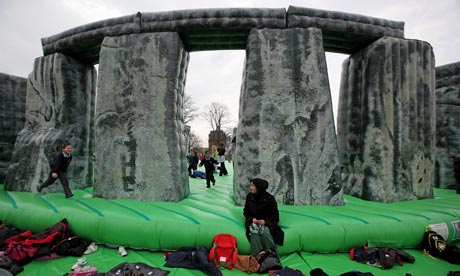 |
Image 1: Graduation Day at Bishop
Grosseteste University College
Lincoln: Let's hope nobody saw
it as a bad omen! |
 |
Image 2: Humidity strip lying on my
desk in the finds room. |
Apart
from making Graduation Day at Bishop Grosseteste University College Lincoln
look like a rather miserable event (see image 1) the bad weather this summer is wreaking havoc upon our archaeological finds!
The constant downpour has made the relative humidity skyrocket (see image 2) and makes it
incredibly difficult (if not impossible) for our wet finds to dry out
naturally.
Now I’m not that concerned (well not more than I normally am) about
the metal artefacts as they’re stored in sealed containers with bags of silica
gel, but I’m starting to get very worried about our ceramics and bones.
In the
past we would put the wet ceramics, after it had been washed, on dry sheets of
newspaper to dry out naturally. When they were considered dry enough they were
then put in reclosable polyethylene bags and stored in the archives. In the
past this seemed to have worked well enough. However, last year Zoe Tomlinson,
our finds supervisor, found a few sealed bags with ceramics from the previous
year that had gone mouldy because they had been stored too wet.
 |
Image 3: Finds drying out in the
scanner room. |
As a consequence of this
accident, as well as the problems we currently have with the humidity, we are
now frantically trying to figure out new ways to dry out the finds so that when
they’re sent to the archives they’re dry enough to prevent the formation of
mould. One of the first experiments we
tried was simply to put the ceramics in a tray in the oven at 30 °C for a
couple of hours to see if the heat would dry the ceramics out. It didn’t really
work out that well. As soon as we took the ceramics out of the oven, put them
in bags, and transported them back to the finds room, where the ceramics
started to cool off, condensation appeared on the inside of the bags.
 |
Image 4: Humidity strip
inside the scanner room. |
The next experiment we then tried was to
store finds trays with cleaned wet finds for a day or two in the Bischop
Grosseteste’s Scanner Room (image 3 and 4) . As this room is rather small and not
used at the moment, we thought that it might be relatively easy to create a
dryer environment in it. We installed a small space heater inside the room,
opened a window, stuck a humidity strip unto the shelves and waited for the
humidity to drop. As you can see when you compare image 4 to image 2, the humidity
in image 4 is quite a bit lower. We were rather optimistic about this approach,
but once again, it failed to work. After we bagged the ceramics up in order to
take them to the finds room it didn’t take very long (an hour or so) before
condensation appeared on the inside of the bags.
 |
Image 5: Two finds bags filled with
ceramics lying on my desk in the finds
room. The left bag contains the sachet
with silica gel. |
 |
Image 6: The result of the failed silica
gel test. The humidity inside the bag
is in fact slightly higher than the
humidity inside the room. |
So it was back to the oven. However,
instead of removing the ceramics from the oven after turning the oven off, we
decided to leave the ceramics overnight in the (turned off) oven, so they could
cool off before bagging them up. I then put a humidity strip in one bag with
ceramics so I could see what the humidity inside it was, and placed a bag of
silica gel with a humidity strip in the other (see image 5). The idea was that the
silica gel would dry out the ceramics inside the bag. Of course, as you can see
on image 6, it didn’t work. In fact, it actually looked like the relative
humidity inside the bag with the silica gel was higher than it was inside
the finds room…
Now, I’m not entirely sure whether this
is because the bags aren’t airtight and the silica gel is sucking up moisture
from the room, or whether the silica gel is sucking up the water from the
ceramics and that this is the reason why the humidity in the bag is higher than
inside the finds room.
However, it proves that I still haven’t
found the solution to our problem! If
anyone has any advice that they’re willing to share with me on how I might be
able to solve our problem, I’d be very grateful!



